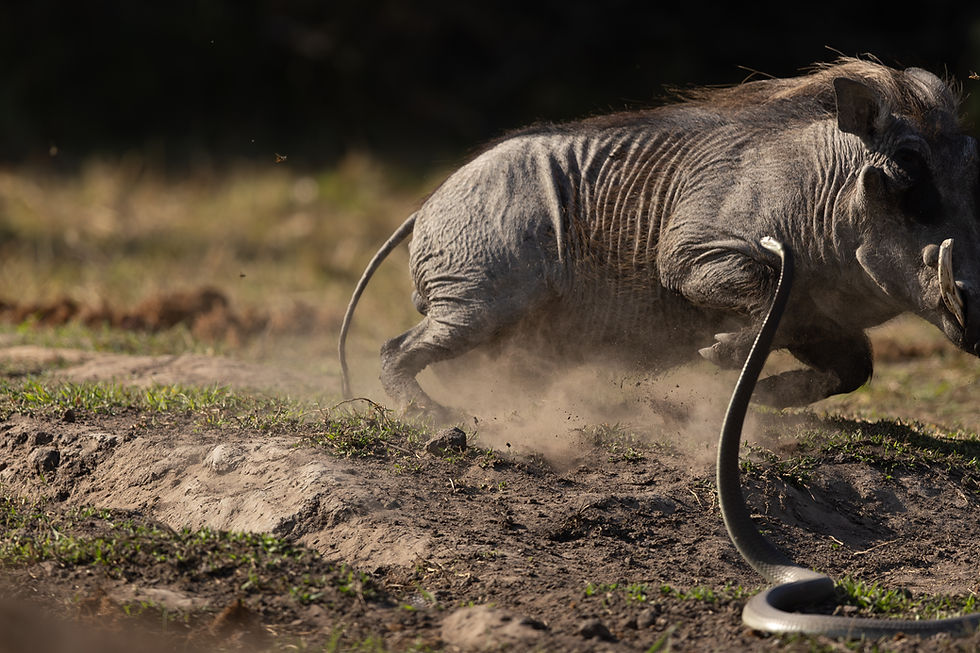24 Hours at the Kamasot Hide! by Phil Jeffery
- Tyrone McKeith

- 6 days ago
- 3 min read
OK, not quite, but you get the picture! I finally took some time to enjoy the wildlife hide that we have been working on in Kafue and it did not disappoint! For a bit of context, Kamasot is a big open plain away from the Kafue River to the east of Musekese and Lwenge Camp – in the dry season it is home to many of our larger mammals, like roan and sable, and the natural waterhole alongside it becomes a hive of activity.

In previous years, through the Department of National Parks & Wildlife, we had drilled a borehole close by to support the anti-poaching and conservation efforts – this means we can top it up in particularly dry years if needed.
Tuesday 1430hrs: I arrived after lunch to work on setting up a couple of cameras that we can connect to remotely and see what’s going on. Shortly after I arrived a large warthog came into the clearing, so I ducked inside so that he could drink. He disappeared down a dip and came flying back out with a cobra in tow! I was too slow (and had too much lens!) so didn’t quite get ‘the shot’, but it was amazing nonetheless! I went back out into the sun and carried on being a tech nerd. Once I’d geeked out with the cameras I settled in for the rest of the afternoon.

The afternoon was a little quiet, perhaps due to me having been outside, but just after 5pm the leopard that was seen by the guests in the morning cam back for a drink – I had my head in my laptop so missed it (there’s a lesson there…!), catching a glimpse out of the corner of my eye. Soon after came some Lichtenstein’s hartebeest, Schalow’s turaco, honey badger and a pair of hippo. By now the light was fading so I went back to camp to return before sunrise.


I got to the hide well before dawn and opened up the hatches to sit and wait – three wild dog ran in for a quick drink, but it was still dark. I hoped they might come back. A small group of bushpig came in as the birdsong began and thereafter it was a procession of guineafowl, hundreds of doves (being pursued now and again by a little sparrowhawk – too fast for me!), spurfowl and more. As it warmed up so came the baboons, monkeys, impala and warthog; a majestic sable bull quenched it’s thirst. Later in the morning the elephants arrived – a few bulls at first and then a magnificent breeding herd took over the waterhole. This was a highlight for me and I could have filled a dozen cards on my camera. It was also a privilege just watching in silence, as young bulls tussled playfully, testing their strength, and calves mud bathed mere metres away. This was my first real experience in our hide and I was absolutely blown away, I couldn’t have wished for more. Once the elephants left I called it a day and so capped (almost!) 24 hrs at our hide!

Whilst I was lucky (patient!) it is important to remember the nature of wildlife viewing from a hide – the hide doesn’t move, like a vehicle does, and so you rely on the wildlife coming to you and there will be periods of silence and inactivity, that’s nature. But don’t let that dissuade you, it is a wonderful experience sitting in silent anticipation for what might come, and those who have the patience are often rewarded!
Hints & tips:
Animal movements change with the seasons, so speak to your guide about the best time to be there depending on what your specific interests are.
Remember, you want to be in the hide well before any anticipated activity might start so as to not disturb anything.
You don’t have to be a photographer to enjoy sitting in the hide!
If you are a keen photographer, I found the following lenses appropriate for various images at our hide, bearing in mind that all hides are different:
50mm – great for wide angles, particularly scenery and/or a herd of elephants drinking;
70-200mm – this would have been perfect for full body portraits of elephant drinking at the waterhole;
300mm – great for full body portraits of larger antelope drinking, such as sable, hartebeest;
400mm/600mm – perfect for portraits of large carnivores or elephant details etc.
600mm+ – for the birders!
Silence is golden!







Comments